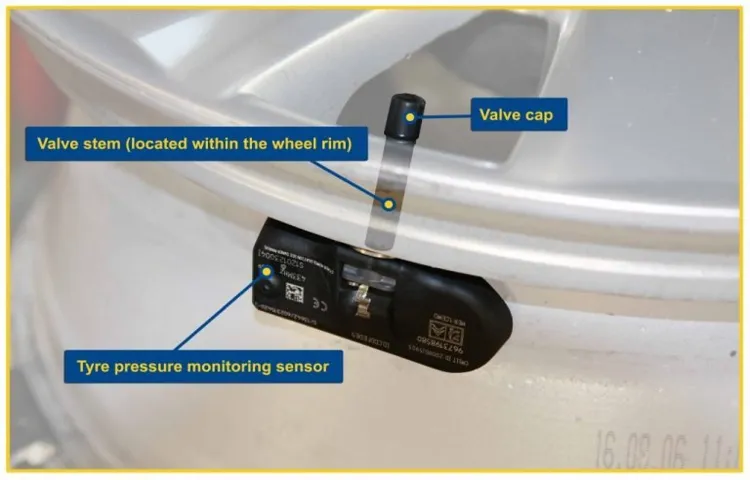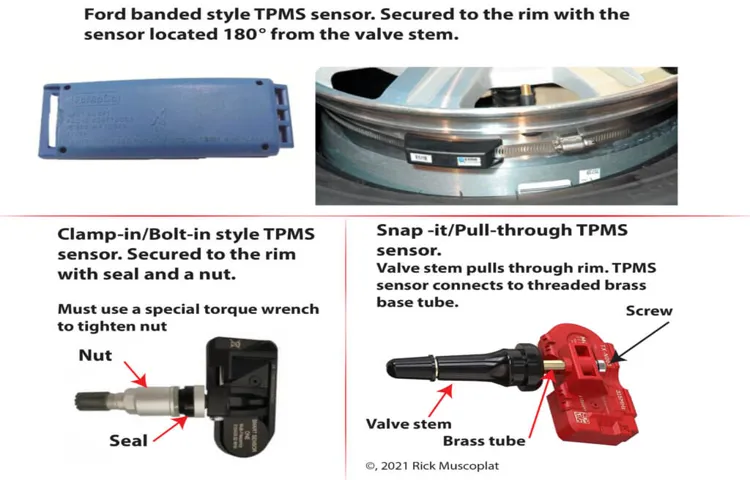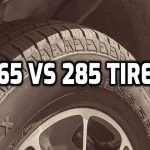Have you ever been driving and suddenly noticed the tire pressure warning light on your dashboard illuminate? It’s a frustrating and confusing experience, as there may not be any visible signs of a flat tire. However, there’s a technology that can help you avoid this situation altogether – the tire pressure sensor. Tire pressure sensors are small devices installed in each wheel that monitor the air pressure within the tire.
These sensors communicate with your car’s computer system, sending real-time readings of the tire pressure. This technology allows you to receive instant feedback if the pressure is outside of the recommended range, notifying you before a potential safety hazard emerges. But tire pressure sensors don’t just signal a warning light.
They communicate with your car’s computer, transmitting crucial data about the functionality of the vehicle. With this technology, you can diagnose potential problems early, such as a malfunctioning tire or low gas mileage, allowing you to address issues before they turn into serious problems. In this blog, we’ll explore the benefits of tire pressure sensors and how they communicate with your vehicle’s computer system to improve safety, efficiency, and overall driving experience.
We’ll discuss the intricacies of this communication system and how it can enhance your driving experience, saving you time and, more importantly, potentially saving your life.
Table of Contents
Introduction
Have you ever wondered how your car’s tire pressure sensor communicates with your vehicle’s system? Well, it’s simpler than you might think. The tire pressure sensor contains a small battery-operated transmitter in the tire’s valve stem that sends wireless signals to your car’s onboard computer. These signals are then processed by the computer, and if the tire’s pressure is too low, it alerts the driver through the dashboard display.
The sensor works by measuring the air pressure inside the tire and transmitting that information via radio frequency to the system. It is a vital safety feature that can help prevent accidents caused by dangerous tire blowouts due to underinflation. It’s essential to check your tire pressure regularly to ensure that your sensors are working correctly and that your car is not at risk of tire-related accidents.
So, make sure you take care of your tires and appreciate the crucial role tire pressure sensors play in keeping you safe on the road.
What is a tire pressure sensor?
A tire pressure sensor is a small component in modern vehicles that monitors the air pressure in the tires. This sensor is typically located inside the wheel well and works by measuring the pressure and sending a signal to the onboard computer system, which then alerts the driver if any tire is low on air. This warning system can help prevent accidents caused by underinflated tires, improve fuel efficiency, and extend the life of your tires.
Think of it as a little guardian angel keeping an eye on your wheels and ensuring that they are in good condition. So, the next time you see that warning light pop up on your dashboard, remember that it’s your trusty tire pressure sensor doing its job.

Why is it important to have a tire pressure sensor?
Tire pressure sensors are essential components of modern vehicles. These devices play a crucial role in maintaining optimal tire pressure and ensuring safe and efficient driving. The sensors are mounted on the tire’s inside and are designed to measure and transmit the air pressure to the control module.
This process is critical because having the correct tire pressure increases fuel efficiency, tire lifespan, and overall vehicle safety. A tire pressure sensor warns drivers when pressure drops below the recommended level, reducing the risk of a blowout or other accidents. It also prevents over-inflation, which can cause excessive tire wear and poor handling.
Overall, the importance of a tire pressure sensor cannot be overstated since it can significantly improve tire performance, increase fuel efficiency, and enhance vehicle safety.
How Does it Work?
Have you ever wondered how your car’s tire pressure sensors are able to communicate with the vehicle’s computer system? These sensors work by using radio frequency technology to send and receive signals between the tires and the car’s onboard computer. Each tire has its own sensor that constantly monitors the air pressure in real-time. If the pressure drops below or rises above the recommended level, the sensors will send a signal to the computer system which will then alert the driver by illuminating a warning light on the dashboard.
This technology not only ensures that your tires are properly inflated but also helps improve fuel efficiency and tire longevity, which can save you money in the long run. So next time you see that glowing tire pressure warning light, you’ll know exactly how it works to help you keep your car running safely and efficiently.
Sensor Placement on the Car
Sensor Placement on the Car One of the most crucial aspects of autonomous vehicle technology is the placement of sensors on the car. These sensors play an essential role in gathering data about the car’s surroundings, including obstacles, pedestrians, and other cars. Most autonomous cars have sensors such as LiDAR, radar, and cameras placed around the car, including on top of the car, in front, and at the side.
The LiDAR sensors work by emitting a laser beam, which hits objects in its path, creating a 3D map of the car’s surroundings. Meanwhile, radar sensors use radio waves to detect the distance and speed of objects around the car and can even track objects that are out of sight. Lastly, cameras use visual data to create an accurate view of the car’s environment.
As crucial as these sensors are, the placement of these sensors on the car is equally important. The car’s sensors must be placed in areas where they can detect obstacles accurately, but also, they need to avoid damage during a potential collision. For example, sensors placed on the car’s bumper must be able to detect obstacles without getting damaged in a collision.
In conclusion, autonomous car technology relies heavily on sensor placement to ensure safety and reliability while on the road. The placement of sensors around the car allows for an accurate and complete picture of the car’s surroundings, making it easier for the vehicle to determine its course and avoid accidents. Therefore, it’s crucial to design and test sensor placement on the car to ensure maximum efficiency and safety, even in unexpected situations.
Electronic Communication between Sensor and Car
Electronic communication between a sensor and a car is an essential aspect of modern cars. It allows the car to collect data from various sensors and feed it into the car’s computer, making it easier for the car to respond to various situations. This process works through a series of sensors placed in and around the car that monitors various aspects of the car’s performance, such as its speed, fuel consumption, and temperature.
When the sensors detect changes in any of these areas, they send a signal to the car’s computer, letting it know that there is a potential problem. The computer can then use this information to adjust the car’s behavior, such as adjusting the engine’s speed or changing the car’s speed. This communication between the sensor and the car is critical to make the car more efficient and safer to operate.
Overall, electronic communication between a sensor and a car is an excellent technological advancement that ensures faster response times and better performance while driving.
Data Displayed to the Driver
As cars become more advanced with the latest technology, one crucial component that has evolved is the data displayed to the driver. This data is vital in keeping drivers informed of their vehicle’s status and overall performance. The modern car dashboard is equipped with a range of sensors that collect different types of data, such as fuel consumption, speed, and engine temperature.
The collected data is then processed and displayed on the dashboard in intuitive ways, such as through digital gauges, indicator lights, and graphical display options. The driver can monitor various aspects of their vehicle’s performance, which helps them make informed decisions while driving. This advanced technology has enabled drivers to have greater control over their vehicles, leading to improved safety and fuel efficiency.
As a result, car manufacturers continue to invest in developing advanced data analytics and display technologies to enhance the driving experience for their customers.
Benefits of a Tire Pressure Sensor
Tire pressure sensors have become a standard feature in almost all new cars. These sensors are very beneficial as they help detect when a tire has lost air pressure, which can significantly affect the vehicle’s handling and fuel efficiency. But how does a tire pressure sensor communicate with a car? The tire pressure sensors use radio frequency identification technology to transmit the tire’s air pressure data to the car’s computer system.
This communication ensures that the driver can receive real-time alerts regarding tire pressure, which can prevent accidents or damage to the vehicle’s tires. The system works by having a sensor mounted on each wheel that sends a signal to the control unit, which then processes the data and sends it to the car’s dashboard. This allows the driver to quickly and easily identify which tire is underinflated and take corrective action.
Overall, having a tire pressure sensor is a great way to improve safety, reduce fuel consumption, extend the life of your tires, and save you money on costly repairs.
Safety
Safety Driving with underinflated tires can not only impact the performance of your vehicle but also compromise your safety on the road. This is where a tire pressure sensor comes in handy. By monitoring the air pressure inside your tires, this device can alert you when pressure levels are low, allowing you to take appropriate action quickly.
This not only ensures a smoother ride but also helps prevent tire blowouts, which can be dangerous and even life-threatening. Taking the time to ensure that your tire pressure is accurate is a simple step towards keeping you and your passengers safe on the road. So why not invest in a tire pressure sensor for peace of mind and added safety?
Saving Money on Gas
Gas prices are always fluctuating and can put a dent in our wallets. That’s why finding ways to save money on gas is crucial. One way to do this is by using a tire pressure sensor.
This nifty device can detect when your tires are low on air and alert you before it affects your gas mileage. By maintaining proper tire pressure, your car can run more efficiently, ultimately leading to more money saved. Plus, it can also improve the overall safety and performance of your vehicle.
Think of it like this: just like you need the right amount of air in your lungs to breathe properly, your car needs the right amount of air in its tires to function to its fullest potential. So, investing in a tire pressure sensor can not only help your wallet but also benefit your car in the long run.
Tire Maintenance
Tire pressure sensors are a must-have for any vehicle owner, as they provide numerous benefits. One of the primary benefits of a tire pressure sensor is that it helps to ensure that your tires are properly inflated at all times. This is essential because even a small deviation in your tire pressure can lead to decreased fuel efficiency, reduced tire lifespan, and even total tire failure.
The sensor would alert you immediately if there is any deviation, allowing you to take prompt action to get your tires back to the correct pressure. Apart from keeping you safe and saving you money, the sensor would also improve your vehicle’s performance on the road. In summary, a good tire pressure sensor is an investment that would ultimately pay off in many ways, so be sure to get one today for your vehicle.
Conclusion
So, there you have it folks – the secret to how tire pressure sensors communicate with cars! It’s all about sending radio waves back and forth, kind of like when you’re playing a game of catch with your friend. Only instead of tossing a ball, it’s sending important information about your tire pressure. And just like any good game of catch, it’s all about timing and accuracy.
So next time you’re driving down the road and your tire pressure warning light comes on, you can appreciate all the behind-the-scenes magic that goes into making that happen, just like a pro athlete hitting the perfect pitch or a quarterback throwing the winning pass.”
FAQs
What is a tire pressure sensor?
A tire pressure sensor is a small device installed inside the tire that monitors the air pressure of the tire and sends this information to the car’s computer.
How does a tire pressure sensor communicate with the car?
A tire pressure sensor communicates with the car through a radio frequency signal that is sent to a receiver in the car’s computer.
Is it necessary to have a tire pressure sensor installed in every wheel of your car?
Yes, it is necessary to have a tire pressure sensor installed in every wheel of your car because it provides accurate information about the air pressure in each tire.
What happens if the tire pressure sensor malfunctions?
If the tire pressure sensor malfunctions, the car’s computer may not receive accurate information about the tire pressure, which could lead to unsafe driving conditions.
How often should you check your tire pressure?
You should check your tire pressure at least once a month, or more frequently if you notice that your tires are losing air or if you’re driving in extreme conditions.
Can the tire pressure sensor be replaced if it stops working?
Yes, the tire pressure sensor can be replaced if it stops working, but it is important to have it replaced by a qualified mechanic to ensure that it is installed correctly.
Are there any benefits to having a tire pressure sensor installed in your car?
Yes, there are several benefits to having a tire pressure sensor installed in your car, including improved fuel efficiency, increased safety, and longer tire life.



